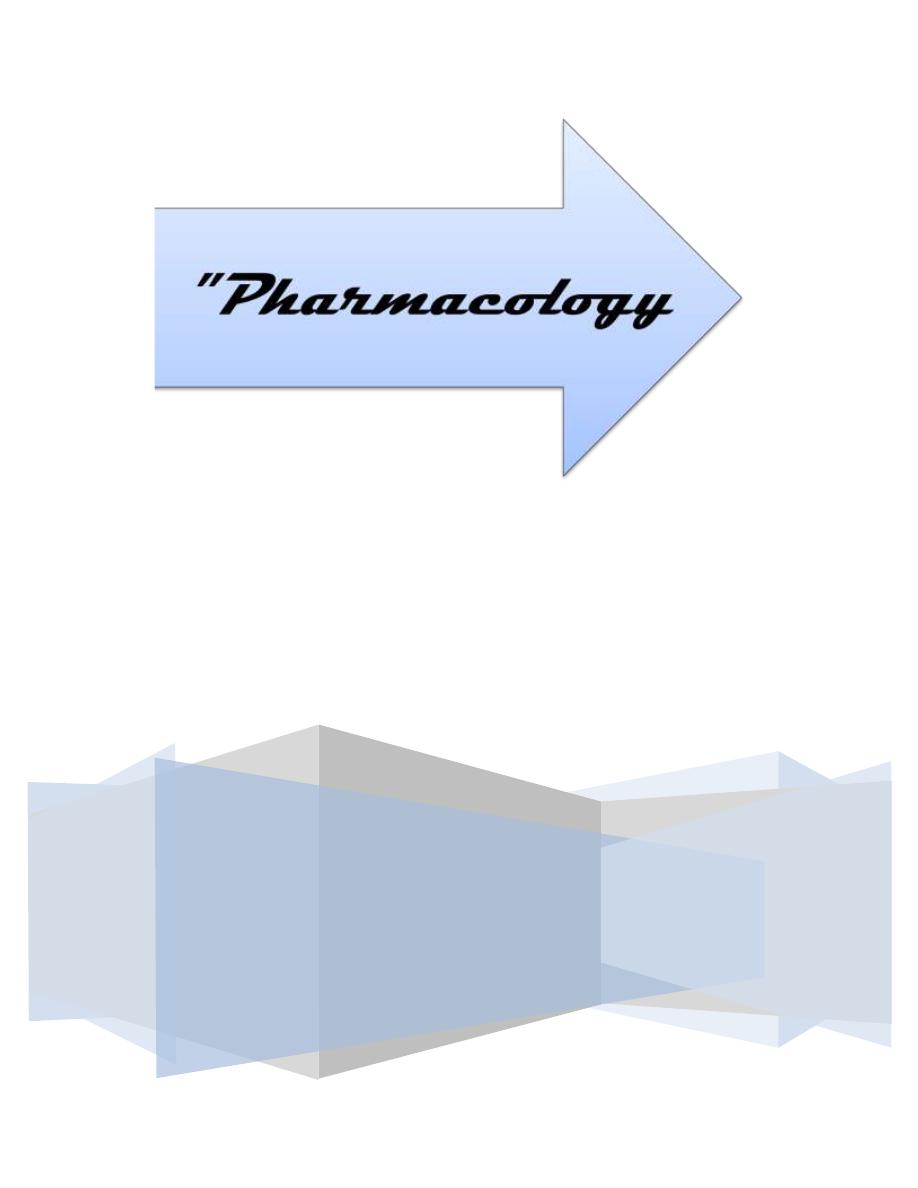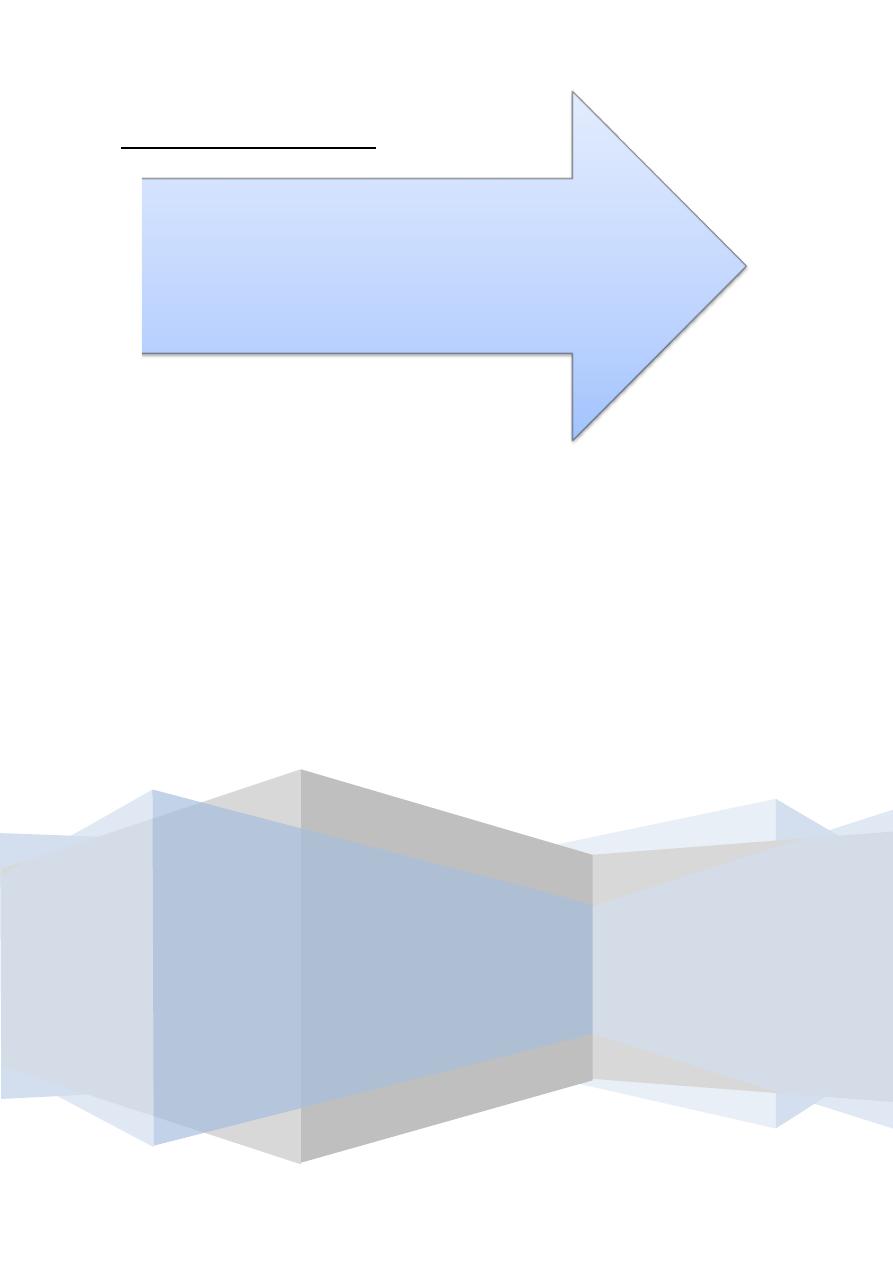
Sunday 7 / 12 / 2014
©Ali Kareem 2014-2015
Name
:
______________________________
Class
:
_______________________________
مكتب اشور لالستنساخ
EICOSANOIDS
Lecture 5
Total lectures NO. 25
Dr. Ahmad Al-Zohyri

I
Name
:
______________________________
Class
:
_______________________________
"Pharmacology
Eicosanoids
Lecture
د
.
احمد الزهيري

Eicosanoids
Mahmood Saied ® 2011
Page 2
Eicosanoids
They are oxygenated products of polyunsaturated fatty acid (PUFA). They are
a large family of compounds highly potent with a wide spectrum of biological
actions. *They have a very short t
1/2
(half life seconds to minutes).
Most important of these compounds are prostaglandins (PGs),
Leukotriens
(LTs) and thromboxanes (TXs).
They are produced in minute (small) amounts by all cells except RBCs and they
act locally i.e. at the same site of synthesis
.
Their inactivation is rapid (also local) i.e. they don't circulate in blood in
significant concentration.
So they have low blood concentration because they are synthesized, released,
act and inactivated locally by the same tissues,
so they don't need to
circulate.
Eicosanoids are not found preformed in tissues. They are generated de novo
from phospholipids.
They are implicated in the control of many physiological processes [e.g.
mediators and modulators of inflammatory reactions]
Many stimuli liberate arachidonic acid (AA),
(vary with cell type).
(i.e. thrombin in the platelets,
bradykinin in fibroblasts,
and antigen-antibody
[Ag-Ab] reaction on the mast cells). General cell damage also starts the
process of liberating AA.
Arachidonic acid is the source of Eicosanoids.

Eicosanoids
Mahmood Saied ® 2011
Page 3
Prostaglandins (PGs):
Synthesis:
Arachidonic acid,
which is a 20 carbon F.A.,
is the primary source of PGs &
related compounds (LTs, TXs …); it is present in the phospholipids of cell
membrane
.
Arachidonic acid is released from tissue phospholipids by the action of
phospholipase A2.
1. Cyclo–oxygenase pathway:
Eicosanoids with ring structure (i.e. PGs,
TXs and prostacyclines) are
synthesized by this pathway.
Two cyclo-oxygenase (2 enzymes) have been identified: COX-1 & COX-2.
COX-1 is ubiquitous and constitutive (i.e. housekeeping function).
COX-2 is induced in response to inflammatory stimuli.
2. Lipoxygenase pathway:
Several lipoxygenase can act on the A.A (5-,
12-,
&15- lipoxygenase) to form
unstable peroxidated derivatives converted into LTs or LXs (lipoxins) depending
on the tissue.

Eicosanoids
Mahmood Saied ® 2011
Page 4
DIAGRAM
Mediators derived from phospholipids & their action & their sites:

Eicosanoids
Mahmood Saied ® 2011
Page 5
Prostanoids (PGs and TXs):
COX enzyme acts on arachidonate to produce cyclic endoperoxides (PGG
2
,
PGH
2
), these give rise to:
PGI
2
(prostacyclin): from vascular endothelium, act on IP receptors.
The main effects:
1)
Vasodilatation and
2)
Inhibition of platelets aggregations.
TXA
2
: mainly from platelets,
is acts on TP receptors,
the main effect are:
1)
Vasoconstriction and
2)
Platelets aggregation (opposite to PGI
2
).
PGE
2
:
the main effects:
On EP
1
receptors → contraction of the bronchial and GIT smooth muscles.
On EP
2
receptors → relaxation of bronchial, vascular and GIT muscles.
On EP
3
receptors→ 1) Inhibition of gastric acid secretion.
2) Increase in gastric mucous secretion.
3) Contraction of pregnant uterus and GIT smooth
muscles.
PGE
2
is a mediator of fever.
PGF
2
α : act on FP-receptors (found in smooth muscle and corpus
luteum,
main effect is contraction of uterus)
.
PGD
2
:
from mast cell mainly,
acts on DP receptor, the main effect is:
vasodilatation and inhibition of platelet aggregation.
Basic
pharmacology
of Eicosanoids:
Mechanism of action:

Eicosanoids
Mahmood Saied ® 2011
Page 6
PGI
inhibits platelets aggregation through a mechanism by binding to
receptor → activation of adenylate cyclase → ↑ intracellular cAMP →
activation of protein kinase → phosphorylation of internal Ca
++
pump → Ca
++
sequestration that enter the cell (RBCs) → so platelet will NOT aggregate.
contractile effect (especially on smooth muscle) is mediated by the release
of Ca
++
.
Relaxation effect of Eicosanoids is mediated by generation of cAMP.
Effect of PGs & TXs:
1. smooth muscle:
a) Vascular smooth m.:
PGE
2
& PGI
2
relax the human smooth muscle. PGE
2
,
PGI
2
and other PGs
promote vasdilation through activation of adenylate cylclase
.
TXA
2
& PGF
2
α act mostly as vasoconstrictor (especially in veins).
b) GIT smooth m.:
Longitudinal muscles of GIT (intestine) are contracted by PGI
2
& PGF
2
α.
The circular muscles are contracted by PGI
2
& PGF
2
α and are relaxed by
PGE
2
.
c) Airways:
Respiratory smooth mm. are relaxed by PGE
1
,
PGE
2
and PGI
2
,
& they are
contracted by TXA
2
and PGF
2
α
.
d) Genito-urinary tract:
The smooth mm. (especially in uterus) are contracted by PGE
2
and PGF
2
α,
so these are used in labour & abortion.
2. Platelet aggregation:
PGE
1
and PGI
2
inhibit platelet aggregation while TXA
2
promotes platelet
aggregation.
3. Reproductive organs:
a)
♀ reproductive system: will discussed later.
b)
♂ reproductive system:

Eicosanoids
Mahmood Saied ® 2011
Page 7
Semen from a fertile man contain about 400 mg/ml of PGE
2
and PGF
2.
(PGE
2
20:1 PGF
2
). If the ration is different,
then there is something
wrong in fertility.
Testosterone promotes PG production.
TXs and LTs are not found in seminal plasma.
Men with relatively low seminal contents of PG are relatively infertile.
PGs were first isolated from prostate gland,
hence they are called
Prostaglandins.
large doses of Aspirin (NSAIDs) decease the PG content of seminal
plasma → affect fertility
.
4. Nervous system:
a) fever:
PGE
1
& PGE
2
increase the body temperature.
Pyogens release IL-1 which promotes synthesis & release of PGE
2
, this
is blocked by NSAIDs e.g. Aspirin
.
b) sleep: PGD
2
,
when infused into cerebral ventricles,
induces natural
sleep in primates.
c) Neurotransmission: PGE compound inhibit the release of NA from
sympathetic
presynaptic nerve endings.
5.Neuro endocrinology:
Eicosanoids in general,
affect secretion of neurohormones
.
PG compounds
promote the release of GH,
prolactin,
TSH,
ACTH,
FSH,
and LH.
LTC
4
and LTD
4
stimulate LH and LHBH secretion.
Effects of LTs
1. Heart & smooth m.: LTC
4
or LTD
4
decrease myocardial contractility &
decrease coronary blood flow.
2. GIT: epithelium of the colon synthesize LTB
4
which is a chemoattractant for
neutrophils
.
It increases in cases of inflammatory bowel disease.

Eicosanoids
Mahmood Saied ® 2011
Page 8
3. Airway: LTC
4
, LTD
4
and LTE
4
are powerful bronchoconstrictors and they cause
↑ in microvascular permeability, ↑ plasma exudation, and ↑ the mucous
secretion of the airways.
4. Blood cells: LTB
4
is a powerful chemoattractant for neutrophils while LTC
4
and LTD
4
are powerful chemoattractants for eosinophils.
Inhibition of Eicosanoids synthesis:
1.
Corticosteroids:
these block all the known pathway of Eicosanoids by
stimulating the formation of lipocortin (a protein which inhibits the activity of
phospholipase A2
.
i.e. prevent the release of A.A).
2.
NSAIDs:
such as aspirin,
paracetamol (acetaminophen),
indomethacin,
ibuprofen,
they block the formation of PGs and TXs i.e. inhibit the activity of
COX.
Clinical Pharmacology of Eicosanoids:
1.
♀ reproductive system:
a) abortion: PGE
2
& PGF
2
α are well known for their oxytocic action and
when these two are given I.V they cause abortion in 85 % of cases.
b) facilitation of labour: PGE
2
& PGF
2
α effectively initiate & stimulate labour.
c) dysmenorrhea: this condition is attributed to increase in the synthesis of
PGE
2
and PGF
2
α during menstruation (in this case continue for more
than 5 days while normally, it takes 3 days).
2.
CVS:
Eicosanoids are involved in thrombosis mainly because TXA
2
promotes platelet aggregation,
while PGI
2
inhibits it.
2. Respiratory system:
a) PGE
2
is known to be a powerful bronchodilator,
so it is given to
asthmatic persons in the form of aerosol
but in this condition it induces

Eicosanoids
Mahmood Saied ® 2011
Page 9
coughing (considered as a disadvantage).
b) PGF
2
and TXA
2
are strong bronchoconstrictors (mediators of asthma but
they are not the main mediators, they are secondary mediators).
They main mediators are leukatrienes C
4
,
D
4
and E
4
in asthma and other
immune responses.
3. Renal system:
a) PGE
1
, PGE
2
,
and PGI
2
increase the glomerular filtration through their
vasodilatory effect.
b) They also increase water & Na
+
excretion.
4. GIT
: PGs have a protective effect against gastric ulcer (cytoprotection), the
synthetic analogue 10, 16, dimethyl PGE
4
is available for use against
gastric ulcer produced by either steroids or NSAIDs.
Therapeutic uses of PGs:
1. Abortion:
Several of the natural occurring PGs as
dinoproston
and
carboproston
are
used as abortifcients (causing abortion).
Misoprostol
, in combination
with methotrexate are effective in termination
of
pregnancy within the first trimester (1
st
3 months).
2. Peptic ulcer:
Misoprostol
(a synthetic analogue of PGE
1
) is *used to inhibit the secretion
of HCl. In stomach it *inhibits gastric acid & pepsin secretion and *increase
mucosal resistance to injury. *It is useful in patient with gastric ulcer due to
chronic use of NSAID.
Misoporstol produce or cause *uterine contraction so it is contraindicated
during pregnancy. Also it causes a *dose related diarrhea & *nausea & these
are the most common adverse effect.

Eicosanoids
Mahmood Saied ® 2011
Page 10
3.
Erectile dysfunction:
Alprostadil
injected into the corpus c. penis effectively treat some forms of
male impotence.
Alprostadil ↑ the arterial inflow through vasodilation or ↓ out flow by
relaxation of the corporal smooth m. that occludes drainage.
Side effects: Pain at site of injection and rarely prolonged erection (short
duration of action).

• 1-Pediatrics:
PGE1 infusion to maintain patency of the ductus
arteriosus in infants with transposition of the great vs until
surgical correction can be taken.
• 2-Pulmonary hypertension and dialysis
: PGI2 is approved for
use ( as epoprostenol) in severe pulmonary hypertension and
to prevent platelet aggregation in dialysis machines.
• 3-Ophthalmology:
PGF2α derivatives ( Latanoprost) is used
extensively for the topical treatment of glucoma (also
bimatoprost, travoprost and unoprostone are newer related
drugs).These agents increase the outflow of aqeous humor,
thus reducing intraocular pressure.
Clinical uses of eicosanoids
